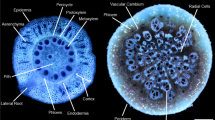Summary
Experiments were done to test whether N fixation is more sensitive to high soil temperatures in common bean than in cowpea or soybean. Greenhouse experiments compared nodulation, nitrogenase activity, growth and nitrogen accumulation of several host/strain combinations of common bean with the other grain legumes and with N-fertilization, at various root temperatures. Field experiments compared relative N-accumulation (in symbiotic relative to N-fertilized plants) of common bean with cowpea under different soil thermal regimes. N-fertilized beans were unaffected by the higher temperatures, but nitrogen accumulation by symbiotic beans was always more sensitive to high root temperatures (33°C, 33/28°C, 34/28°C compared with 28°C) than were cowpea and soybean symbiosis. Healthy bean nodules that had developed at low temperatures functioned normally in acetylene reduction tests done at 35°C. High temperatures caused little or no suppression of nodule number. However, bean nodules produced at high temperatures were small and had low specific activity. ForP. vulgaris some tolerance to high temperature was observed among rhizobium strains (e.g., CIAT 899 was tolerant) but not among host cultivars. Heat tolerance ofP. acutifolius andP. lunatus symbioses was similar to that of cowpea and soybean. In the field, high surface soil temperatures did not reduce N accumulation in symbiotic beans more than in cowpea, probably because of compensatory nodulation in the deeper and cooler parts of the soil.
Similar content being viewed by others
References
Dart P J, Day J, Islam R, and Dobereiner J 1976 Symbiosis in tropical grain legumes: Some effects of temperature and the composition of the rooting medium. pp 361–383.In Symbiotic Nitrogen Fixation in Plants. Ed. P S Nutman. Cambridge University Press.
Dart P J and Mercer F V 1965 The effect of growth temperature, level of ammonium nitrate, and light intensity on the growth and nodulation of cowpea. Aust. J. Agric. Res. 16, 321–345.
Gibson A H 1977 The influence of the environment and managerial practices on the legumerhizobium symbiosis. pp 393–450.In Treatise on Dinitrogen Fixation. IV. Agronomy and Ecology. Eds. R W F Hardy and A H Gibson. Wiley, N.Y.
Graham, P H 1981 Some problems on nodulation and symbiotic nitrogen fixation inPhaseolus vulgaris L.: A review. Field Crops Res. 4, 93–223.
Graham P H and Halliday J 1977 Inoculation and nitrogen fixation in the genus Phaseolus. pp 313–334.In Exploiting the Legume-Rhizobium Symbiosis in Tropical Agriculture. Eds. J M Vincent, A S Whitney and J Bose. Univ. Hawaii, Coll. Trop. Agric., Misc. Pub. 145.
Guss A and Dobereiner J 1972 effects of mineral nitrogen and soil temperature on nitrogen fixation of field beans (Phaseolus vulgaris L.). Pesq. Agropec. Bras. 7, 87–92.
Lie T A 1971 Symbiotic nitrogen fixation under stress conditions. Plant and Soil. Spec. Vol. 117–126.
Lie T A, Hille Ris Lambers D and Houwers A 1976 Symbiotic specialization in pea plants: Some environmental effects on nodulation and nitrogen fixation. pp 319–333.In Symbiotic Nitrogen Fixation in Plants. Ed. P S Nutman. IBP. Vol. 7. Camb. Univ. Press.
Munevar F and Wollum A G 1982 Response of soybean plants to high root temperature as affected by plant cultivar and rhizobium strain. Agron. J. 74, 138–142.
Munns D N, Fogle V W and Hallock B G 1977 Alfalfa root nodule distribution and inhibition of nitrogen fixation by heat. Agron. J. 69, 377–380.
Pankhurst C E 1973 Rhizobium strain influence on disruption of clover nodule development at high root temperature. J. Gen. Microb. 74, 219–231.
Pankhurst C E and Sprent J I 1976 Effects of temperature and oxygen tension on nitrogenase and respiratory activities of turgid and water stressed soybean and French bean root nodules. J. Expl. Bot. 27, 1–9.
Piha M I 1985 Ph.D. Thesis, University of California, Davis.
Singleton P W and Stockinger K R 1983 Compensation against ineffective nodulation in soybean. Crop Sci. 23, 69–72.
Sprent J I and Minchin F R 1984 Environmental effects on the physiology of nodulation and nitrogen fixation. pp 269–317.In Temperate Legumes: Physiology, Genetics and Nodulation. Eds. D G Jones and D R Davies. Pitman.
Author information
Authors and Affiliations
Rights and permissions
About this article
Cite this article
Piha, M.I., Munns, D.N. Sensitivity of the common bean (Phaseolus vulgaris L.) symbiosis to high soil temperature. Plant Soil 98, 183–194 (1987). https://doi.org/10.1007/BF02374822
Received:
Accepted:
Issue Date:
DOI: https://doi.org/10.1007/BF02374822




